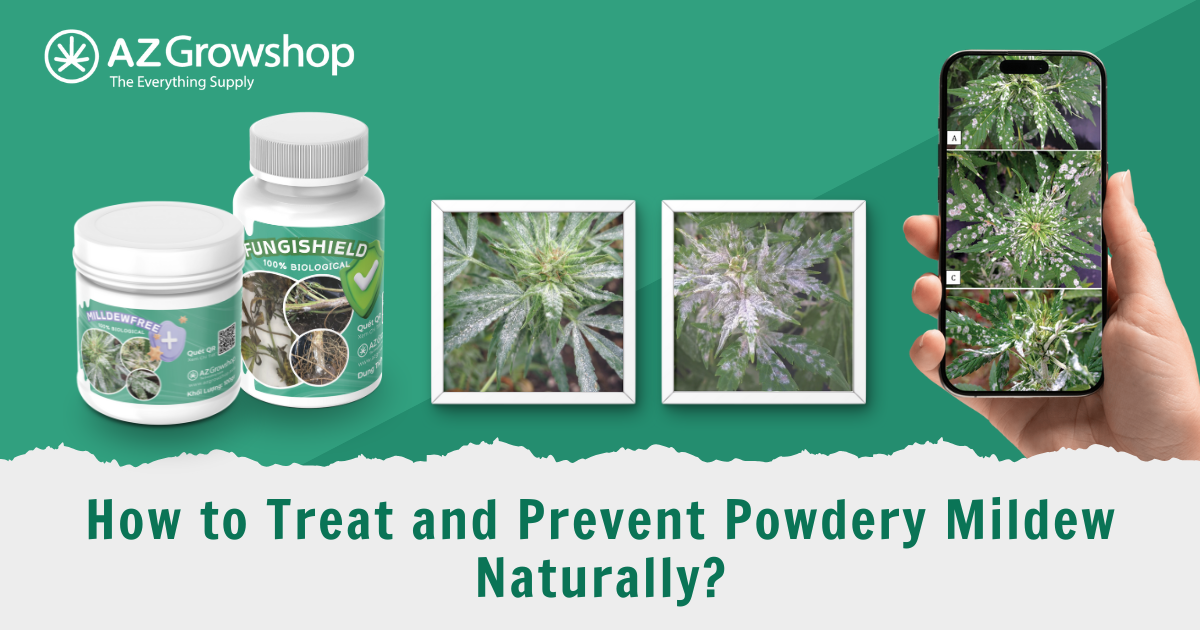Understanding Powdery Mildew and Symptoms
Powdery mildew is a pervasive fungal disease that affects plants, particularly those growing in warm, dry climates. If you've noticed a powdery, white substance on the leaves or stems of your plants, you're likely dealing with powdery mildew. It can significantly impact both ornamental and edible plants, reducing their vigor and growth. Recognizing and treating powdery mildew early is essential to preventing widespread plant damage and ensuring a healthy garden.
1. What is Powdery Mildew?
Powdery mildew is caused by various fungal species, each targeting specific plant types. For instance, Podosphaera xanthii is a common culprit among cucumbers and squash, while Microsphaera syringae typically affects lilacs. This disease is particularly active from late spring to early summer when weather changes are most noticeable.

Unlike other fungi that need high humidity, powdery mildew can thrive in dry conditions, so long as plants are crowded or lack proper airflow. Spores spread easily via wind, insects, and contaminated tools, making powdery mildew one of the most contagious plant diseases.
2. Symptoms and Identification

Recognizing powdery mildew early can save your plants from extensive damage. Common symptoms of powdery mildew include:
- White or Gray Spots: Powdery mildew first appears as small, circular, powdery spots on the upper surface of leaves. These spots can spread quickly, covering leaves, stems, and even flower buds and fruits.
- Yellowing or Wilting Leaves: As the disease progresses, infected leaves may turn yellow, wilt, and eventually drop. Powdery mildew restricts photosynthesis by blocking sunlight, reducing the plant's ability to generate food.
- Distorted Growth: Young, infected leaves or buds may become twisted or stunted. This effect can be especially harmful to plants in their early vegetative stage, impacting their overall health and vitality.
Plants that are particularly susceptible to powdery mildew include cucumbers, roses, zinnias, and squash and especially hemps and weeds. Recognizing these symptoms early is crucial to stop the disease from spreading and weakening nearby plants.
3. Spread and Impact on Plant Health
Powdery mildew spreads rapidly in favorable conditions, such as high humidity during the night and lower humidity during the day, typical of late spring and summer. Fungal spores travel through the air or attach to insects and tools, quickly infecting neighboring plants. For some species, such as zinnias and bee balm, overcrowding and poor air circulation heighten the risk of infection.

Without proper treatment, powdery mildew can spread from plant to plant. This reduces both the plants’ aesthetic appeal and their overall health, especially in flowering plants and vegetables, where infected plants often produce fewer, lower-quality blooms. Powdery mildew can lead to decreased resilience and, in severe cases, plant death.
4. Why Early Treatment is Crucial
Treating powdery mildew as soon as symptoms appear can prevent it from overtaking the plant. Early intervention helps to curb its spread to nearby plants, preserving the overall health of your garden. Late intervention can result in widespread infection, necessitating more extensive treatment, increasing expenses and possibly sacrificing infected plants.

Because powdery mildew spores can overwinter in plant debris, early treatment combined with preventative measures, such as proper disposal of infected plant material, is essential. Immediate action preserves your plants' vigor and promotes a healthy garden environment.
Effective Powdery Mildew Solutions and MildewFree Application
1. Natural and Organic Treatments
When treating powdery mildew, people prioritize using organic solutions that provide both effectiveness and safety for plants. These options offer eco-friendly ways to combat mildew without harsh chemicals.

MildewFree is a biological product containing various microorganisms that help prevent fungal growth on crops, especially powdery mildew. It is suitable for organic farming and ideal for outdoor, indoor, and greenhouse use.
Baking Soda Solution
A baking soda solution is a tried-and-true method to prevent and treat powdery mildew. Combine one tablespoon of baking soda, half a teaspoon of liquid soap, and a gallon of water. This mix helps change the pH on leaf surfaces, making it less hospitable for mildew to thrive. Spray the solution on all affected areas, including the tops and undersides of leaves.
Milk Spray
Another effective option is a milk spray. Dilute milk with water at a 1:2 ratio, then spray the mixture on infected plants. The enzymes in milk not only combat powdery mildew but also stimulate the plant’s immune response, making it more resistant to future infections.
Neem Oil
Neem oil is a natural fungicide and insect repellent derived from the neem tree. When applied to powdery mildew, it helps reduce the fungal spread while also deterring harmful pests. Mix neem oil with water as directed on the bottle and spray thoroughly.
2. Chemical and Preventative Fungicides
While natural treatments are effective, some cases of powdery mildew require a stronger approach. Chemical fungicides are available for severe infestations but should be used sparingly, particularly in organic gardens.
Sulfur-Based Fungicides
Sulfur fungicides are widely used to prevent and treat powdery mildew. Sulfur helps inhibit spore growth on leaves and creates an environment where mildew cannot thrive. Apply as directed and avoid using in temperatures above 80°F, as sulfur can damage plants in extreme heat.
Potassium Bicarbonate
Potassium bicarbonate is another effective option, specifically formulated to fight powdery mildew. It works similarly to baking soda by altering the pH on plant surfaces. Potassium bicarbonate is commonly found in many organic fungicides and is safe for use on edible plants.
3. Prevention Strategies for Powdery Mildew
Preventing powdery mildew is often easier than treating it. Here are some effective strategies to keep this fungal disease at bay.

Optimize Air Circulation
Good airflow reduces humidity around plants, making it difficult for mildew spores to take hold. Regularly thin overcrowded plants, prune dense foliage, and maintain proper spacing to allow air to flow freely through your garden.
Water at the Base
Watering plants at the base minimizes moisture on the leaves, where powdery mildew is likely to grow. Avoid overhead watering and consider using a drip irrigation system to keep foliage dry.
Ensure Proper Sunlight
Since powdery mildew often affects plants in shady areas, place mildew-prone plants in spots with ample sunlight. Sunlight not only helps dry the foliage faster but also boosts the plant’s immunity.
Choose Resistant Varieties
Some plant varieties are more resistant to powdery mildew than others.
4. Introducing MildewFree: A Specialized Solution
MildewFree is is a mixture of nutrients and microflora growth factors extracted from specific microorganisms which prevent the fungus from developing, making it safe for use in organic gardening and effective in various environments, including outdoor gardens, indoor plants, and greenhouses.

Benefits of Using MildewFree
- Organic and Safe: MildewFree is free from harsh chemicals, making it safe for edible plants and gentle on the environment.
- Long-Lasting Protection: It creates a protective barrier on the plant surface, preventing mildew spores from settling.
- Versatile Use: Ideal for multiple applications, MildewFree is suitable for vegetables, ornamental plants, flowers, especially hemp and cannabis.
How MildewFree Enhances Plant Health
In addition to treating powdery mildew, MildewFree enhances the plant's resilience to environmental stressors. Its formula helps plants retain moisture, absorb nutrients, and maintain their overall health, especially during critical growth stages.
5. How to Apply MildewFree for Best Results
Applying MildewFree effectively is essential to maximize its benefits. Here is a step-by-step guide for optimal application.

Preparing the Solution
- Preventive Dosage: Mix 5 grams of MildewFree with 1 liter of water and spray every 10 to 15 days to prevent disease. Adjust the solution to a pH level of 7.5-8.
-
Treatment Dosage:
- Outdoor Use: Spray twice, with a 3-5 day interval, using 5 grams per liter. Then apply a booster/preventive dose every 10-15 days, depending on the crop's condition. The product is biodegradable and should be discontinued 10 days before harvest.
- Indoor and Greenhouse Use: Spray twice, with a 6-7 day interval, using 5 grams per liter. For seedlings or clones, reduce the dosage to 4 grams per liter. Afterward, apply a booster/preventive dose every 10-15 days, depending on the crop's condition. The product is biodegradable and should be discontinued 15 days before harvest.
Thoroughly spray the entire plant, including flowers and the undersides of leaves, ensuring the product is fully absorbed. For optimal results, combine MildewFree with FungiShield, as this mixture accelerates the drying of fungal cells.
FAQs
Can powdery mildew spread to other plants?
Yes, powdery mildew spores spread easily through the air, by insects, and via contaminated tools. Ensuring proper spacing and air circulation can help reduce the risk.
Is powdery mildew harmful to my crops?
Although powdery mildew doesn’t significantly affect your crops, it can reduce yield, flavor, and the overall health of the plant. Treating it early helps maintain the quality of your harvest.
What natural remedies work for powdery mildew?
MildewFree, Baking soda, milk sprays, and neem oil are effective natural treatments. They alter the leaf pH and discourage fungal growth while being safe for the environment.
Conclusion
Powdery mildew can be a persistent issue for gardeners, impacting the health and yield of plants across the garden. From early identification and natural treatments like baking soda and milk sprays to specialized solutions like MildewFree, you now have the tools to tackle and prevent this common plant problem effectively. MildewFree is an ideal choice for sustainable gardening, providing lasting protection without the use of harsh chemicals. Take action today to protect your plants with MildewFree and enjoy a vibrant, healthy garden free from powdery mildew.
Ready to protect your plants from powdery mildew? Try MildewFree now to ensure strong, mildew-free growth and a more resilient garden.




